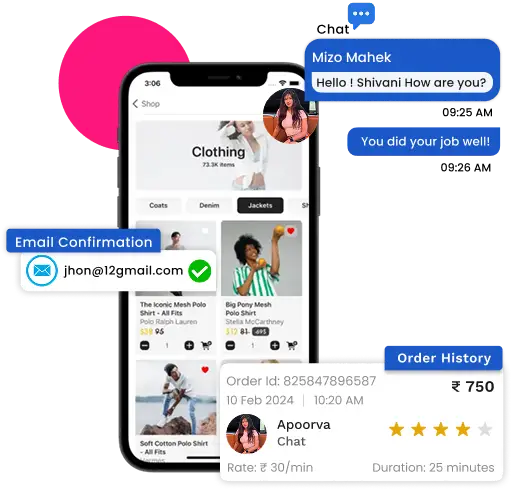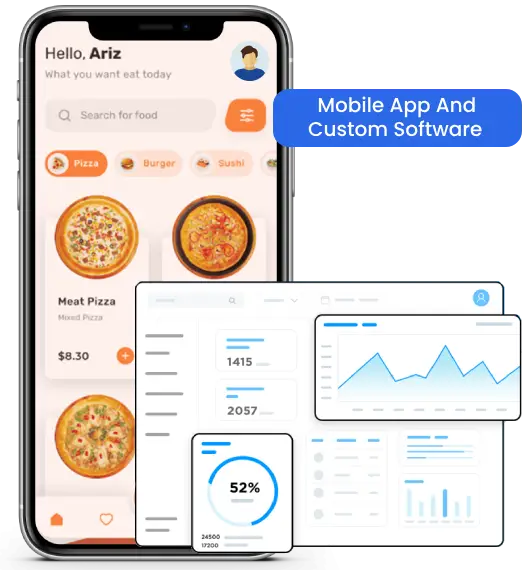Modern app builders face mounting pressure to deliver powerful mobile and web solutions with limited resources. Handling backend infrastructure, APIs, and server maintenance can eat up both time and budget. For teams that want to focus on core functionality and user experience, outsourcing backend responsibilities makes sense. Backend‑as‑a‑Service platforms allow developers to offload many backend tasks without compromising control or flexibility. That leaves more time to focus on design, logic, and user-facing features. Understanding what BaaS offers, and how it shapes modern app workflows, can empower teams to move faster, scale wisely, and innovate with fewer roadblocks. In this blog, we explore what Backend-as-a-Service (BaaS) is, why it’s becoming increasingly popular among developers, the role it plays in modern app development, its core features, and how to choose the right platform for your project.
What Is Backend-as-a-Service (BaaS)?
Backend‑as‑a‑Service refers to cloud-based platforms that handle common backend needs such as data storage, user authentication, real-time messaging, and serverless functions. Instead of building an API from scratch, developers connect their app to a standardized backend service. Authentication, database, and push notification modules become plug‑and‑play. Scalability, reliability, and security infrastructure come built in. Since most backend development focuses on boilerplate work, BaaS cuts down on repetitive coding. Teams can navigate backend logic using SDKs or APIs provided by the service. Whatever your app needs—whether it’s login or media storage—BaaS handles the deployment, maintenance, and updates behind a simplified developer interface.
Why BaaS Is Gaining Popularity Among Developers?
One of the biggest advantages of BaaS is the ability to rapidly prototype applications. Developers can launch functional products without needing extensive DevOps expertise, since there’s no requirement to manage servers or configure databases manually. It allows smaller teams to quickly test ideas and make improvements based on real user feedback.
Budgeting becomes more manageable as well. Initial development costs remain low, and pay-as-you-go pricing models enable teams to scale only as demand grows, eliminating the need for upfront infrastructure investment. Security is another strong benefit. When backend code and data are managed by reliable cloud providers, patches and updates are handled automatically, reducing the risk of human error.
Elastic scaling ensures that apps can grow organically without rewriting backend systems. For businesses looking to reduce time-to-market, avoid operational complexity, and improve product stability, BaaS offers a dependable and efficient approach to modern app development.
The Role of Backend‑as‑a‑Service
BaaS streamlines the development process by handling backend complexities, so developers can focus on building rich, scalable, and user-friendly applications. The following are the roles BaaS plays in transforming how modern apps are developed and maintained:
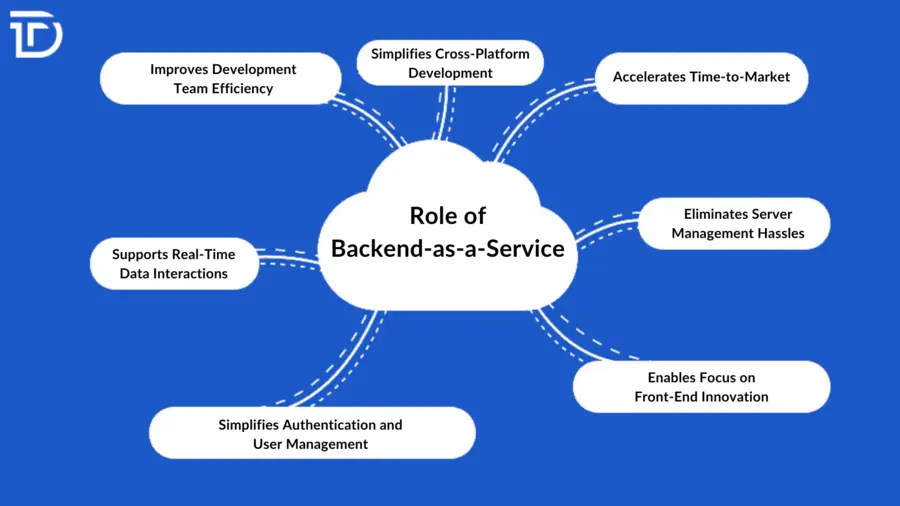
Accelerates Time-to-Market
BaaS platforms provide ready-to-use backend services that significantly reduce development time, allowing teams to deploy applications much faster than traditional methods.
Eliminates Server Management Hassles
Developers no longer need to configure or maintain servers, databases, or hosting environments. The backend infrastructure is automatically handled by the provider.
Enables Focus on Front-End Innovation
With backend concerns offloaded, developers can focus more on designing intuitive interfaces and delivering a superior user experience.
Simplifies Authentication and User Management
Built-in user authentication systems streamline registration, login, password reset, and permissions without the need for manual coding.
Supports Real-Time Data Interactions
Many BaaS platforms offer real-time database updates, enabling features like live chat, collaborative editing, or instant syncing across devices.
Improves Development Team Efficiency
Cross-functional teams can collaborate faster since the backend and frontend can progress independently using modular APIs and SDKs.
Simplifies Cross-Platform Development
BaaS platforms support Android, iOS, and web development with unified SDKs, making multi-platform apps easier to manage.
Core Features of a BaaS Platform
The following essential features define the backbone of a reliable Backend-as-a-Service solution, helping developers accelerate backend tasks without compromising quality.
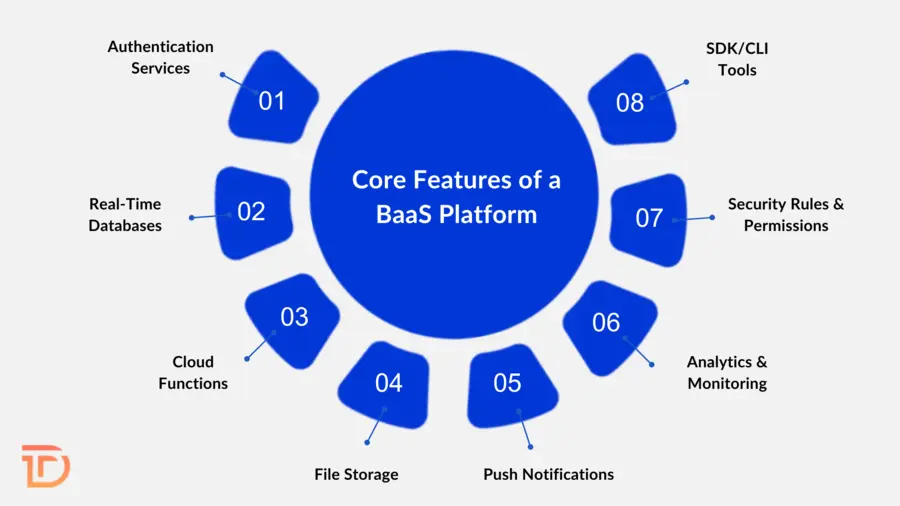
Authentication Services
Modern apps need secure login options such as email/password, social sign-on, phone verification, and multi‑factor authentication. BaaS providers offer pre-built flows and SDKs that simplify setup. A few lines of code let users register, verify accounts, and reset passwords.
Real‑Time Databases
Real‑time and offline syncing capabilities are provided out of the box. Apps like chat platforms, collaborative tools, or gaming leaderboards benefit enormously. Updates become instantaneous and data syncing becomes streamlined between clients.
Cloud Functions
Serverless functions allow developers to run code in response to triggers— user actions, scheduled events, or database updates. Function logic moves out of clients and into the cloud. No need to manage Node.js servers or deployment pipelines.
File Storage
Media, documents, or any kind of asset storage can be hooked into via simple upload and download endpoints. API servers scale across regions automatically without relying on custom file servers.
Push Notifications
Sending messages to users requires server infrastructure, queue management, and delivery logic. BaaS platforms handle that, exposing simple notification APIs tied to user segments or event triggers.
Analytics & Monitoring
Some providers include data reporting tools that track usage, crash logs, or custom events. Developers gain insight into user behavior with minimal instrumentation required.
Security Rules & Permissions
Role‑based access and data visibility policies are defined via declarative rules rather than coded logic. That ensures authorized access and keeps data safe without complex backend logic.
SDK/CLI Tools
Command line or SDK tools help manage projects, deploy functions, roll back changes, or seed test data. Developers save time through faster onboarding and infrastructure automation.
Real-World Examples of Apps Built with BaaS
The following real-world applications showcase how BaaS empowers modern teams to accelerate development, simplify backend operations, and launch scalable digital products with greater efficiency.
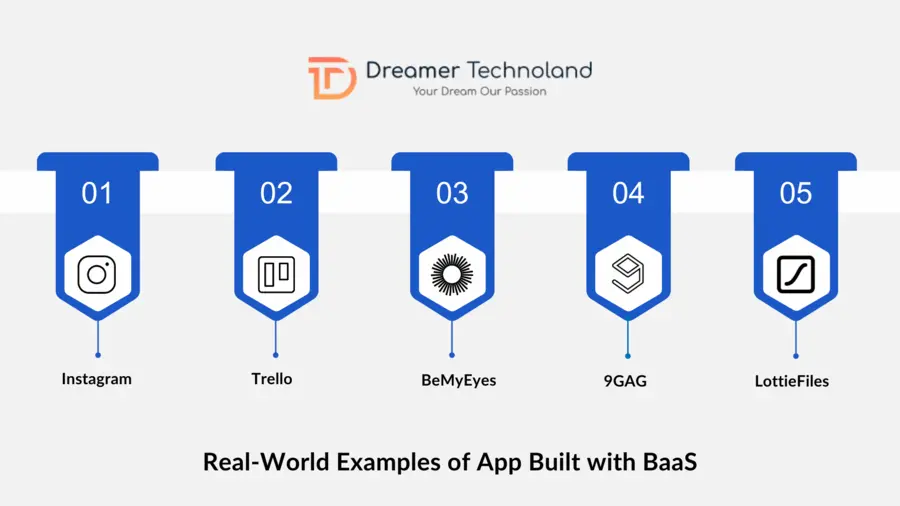
Instagram
The mobile version of Instagram relies on BaaS-like capabilities to manage core features such as real-time messaging, user-generated content, and scalable media storage. Features like comments, likes, and story interactions are updated instantly across devices. Firebase’s real-time database and cloud storage offer the kind of infrastructure Instagram once had to build from scratch. Leveraging similar backend services today allows new apps to replicate Instagram-like functionality with far less engineering overhead.
Trello
Trello, the popular project management and collaboration tool, depends on real-time updates and seamless synchronization between users. With a structure centered around boards, lists, and cards, Trello benefits from BaaS services like real-time databases, authentication, and push notifications. These services make it easy to reflect changes instantly without complex backend deployments, ensuring all team members stay updated in real time across devices.
BeMyEyes
BeMyEyes is an app that connects visually impaired users with sighted volunteers for real-time visual assistance. The platform utilizes BaaS components such as Firebase Authentication and Cloud Functions to handle secure logins, volunteer-user matching, and instant communication. Push notifications and role-based data access rules are used to ensure a smooth and safe experience for both parties, demonstrating how BaaS supports accessibility-focused platforms.
9GAG
Known for its user-generated humor content, 9GAG depends on scalable backend infrastructure to handle massive traffic and user interactions. Firebase powers many of its mobile features, including authentication, content moderation workflows, and real-time comments. Using BaaS allows 9GAG to focus more on user experience and content delivery rather than managing complex backend operations at scale.
LottieFiles
LottieFiles, a collaborative platform for animation professionals, integrates Supabase to power its real-time collaboration, user file storage, and version management. Creators can upload, edit, and preview animations with others across the globe. Supabase enables LottieFiles to manage permissions, database interactions, and file handling without custom backend systems, making the platform more agile and cost-effective to maintain.
Top BaaS Platforms to Consider
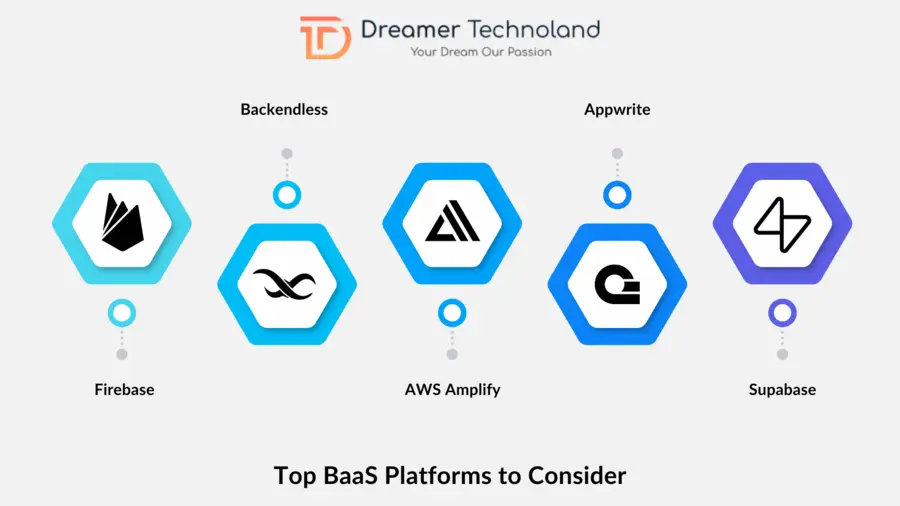
Firebase
Owned by Google, Firebase offers authentication, real‑time database, Firestore, serverless functions, file hosting, and notifications. The generous free tier and strong developer community make it ideal for startups and fast-paced teams.
AWS Amplify
Amazon’s Amplify integrates with AWS infrastructure. Authentication, GraphQL APIs, file storage, and functions hook into existing Amazon setups. It integrates with Cognito, S3, Lambda, and AppSync. Perfect for teams with AWS experience.
Supabase
An open‑source alternative that offers hosted Postgres, row‑level security, real‑time subscriptions, storage, and edge functions. It appeals to developers who prefer SQL databases and transparent, self‑hosted options.
Backendless
Low‑code features, no‑SQL database support, and built‑in UIs for customization. Backendless helps teams build APIs visually without relying solely on code.
Appwrite
Self‑hosted and open‑source, Appwrite provides authentication, database, cloud functions, and storage modules. It supports multiple platforms and allows internal infrastructure control.
How to Choose the Right BaaS for Your Project?
Selecting the right Backend-as-a-Service platform calls for a careful assessment of your app’s architecture, technical requirements, and long-term vision, and the process begins with the following considerations:
Understand Project Requirements and Scalability
Assess both short-term functionality and long-term scalability. Your app’s expected traffic, data volume, and concurrency should align with the BaaS platform’s strengths and limitations.
Match Platform to Technical Stack
Choose a service that fits your team’s technical expertise. Firebase works well for event-driven logic, Amplify integrates smoothly with AWS-based apps, while Supabase suits SQL-centric projects.
Analyze Pricing and Cost Transparency
Examine all pricing aspects including free tier limits, pay-as-you-go structures, bandwidth usage, function calls, and storage. Ensure the model aligns with your budget throughout the app’s lifecycle.
Check Compliance and Security Standards
If your app handles sensitive data, select platforms that offer strong built-in compliance and certifications. Evaluate how they manage authentication, data privacy, and role-based access controls.
Evaluate Community, Support, and Future Readiness
Prioritize platforms with strong community support, detailed documentation, and reliable customer service. Look for migration flexibility, plugin ecosystems, and multi-tenant support to grow beyond MVPs.
How AI and Edge Computing Are Enhancing BaaS
Artificial intelligence transforms BaaS by enabling auto-generated APIs, schema inference, and event-driven machine learning integration. AI-based optimization can restructure queries, suggest indexes, or automatically optimize database layouts. Chat-driven tools help non-expert developers configure authentication flows or complex function triggers. Serverless functions move closer to the user thanks to edge computing. Edge functions handle real‑time validation or authentication at network points nearer to clients. Reduced latency unlocks better user experience in gaming, content editing, or financial apps. Shared code basis helps developers write functions that adapt across regions automatically. AI and edge together empower developers to build stable backend workflows without DevOps overhead and with performance that rivals traditional architectures.
Wrapping Up
Modern backend development has become more accessible thanks to cloud-based services. Backend-as-a-Service platforms take on repetitive server tasks and let developers concentrate on unique business logic. Standard features such as authentication, real-time syncing, storage, and scalable APIs no longer require manual deployment or management. With AI and edge integrations, backend work becomes smarter and closer to users. Choosing the right BaaS platform involves aligning technical capabilities, team knowledge, costs, and compliance. The payoff is faster releases, lower infrastructure overhead, and room for innovation.
Dreamer Technoland is a custom software development company with expertise in integrating Backend-as-a-Service platforms into tailored app solutions. Our team helps clients evaluate the right provider, architect backend structures, and deliver scalable, secure applications. From rapid MVPs to feature-rich platforms, we support every stage with clear communication, clean code, and timely delivery. Reach out to us today to accelerate your app vision using best-in-class backend services and development practices.

